Newcomer goFARM is on a mission to change the face of Australian ag
As a “catalyst of change” goFARM has built a formidable irrigated farming portfolio in just a decade. Boss Liam Lenaghan details their journey so far.
Liam Lenaghan has a grin on his face as he looks at the rows of small trees laden with their first crop of almonds, growing in the back blocks of Katunga in northern Victoria.
It’s only early October but there’s a warm glow in the air and it’s hard to escape the feeling that a long hot summer and an El Nino drought year might be just around the corner.
Many farmers would be worried but not Lenaghan, the tall lanky boss with a larrikin streak of fast-growing Australian-owned $1.1 billion farm investment company goFARM.
With his three-year-old almond trees yielding 40 per cent more nuts than expected in their first producing year, another 160 hectares of newly planted almond seedlings flourishing just across the road, and copious amounts of Murray irrigation water owned by goFARM stored upstream in the bulging Hume and Dartmouth dams, it’s not surprising Lenaghan has a spring in his step.
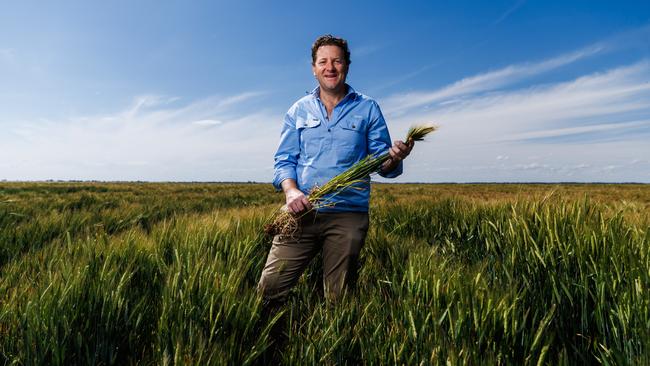
Plentiful and cheap water means more of his crops such as almonds, grapes, corn, beans, citrus and tomatoes can be irrigated with certainty for at least another season, where the needed water pipes, pumps, overhead centre pivot irrigators and irrigation drip tape infrastructure have been put in place.
It also means goFARM’s ambitious plans to transform degraded farmland on a large scale into higher value uses – such as converting dozens of small struggling dairy farms around Katunga to growing high-returning horticultural crops such as almonds and citrus – are succeeding.
And that’s Lenaghan’s – and goFARM’s – main point of difference. His special skill and vision is to find undervalued and under-utilised farmland across Australia that is not producing food or agricultural produce to its greatest potential.
“I like to say we are a property development company more than farm operators,” says Lenaghan, 45. “We are unashamedly a catalyst of change. The difference is that we take farmland and transition and transform it, using capital, know-how, water and technology, to higher-value crops and its best use; essentially unlocking the asset’s full potential.”
Think high-rainfall farms in northern Tasmania that have for generations been used to run traditional Merino sheep.
But which could, with an injection of capital, be converted to grow high-value pinot noir wine grapes or vegetables.
Or sprawling sheep grazing properties in the low rainfall Mallee country north of the Murray River in southern NSW that, with access to expensive irrigation infrastructure and water, could become high-yielding almond plantations.
Or, as in the case of Sandmount Farms at Katunga in northern Victoria, taking 50 rundown family-owned dairy farms that had become too small to be profitable, and whose owners could often no longer afford to irrigate grass to feed their cows. But which, with the addition of soil improvement, land aggregation and modern irrigation – and money plus water entitlements – could be converted to grow higher-returning irrigated crops such as corn, almonds and cereals.
And that’s what goFARM is doing.

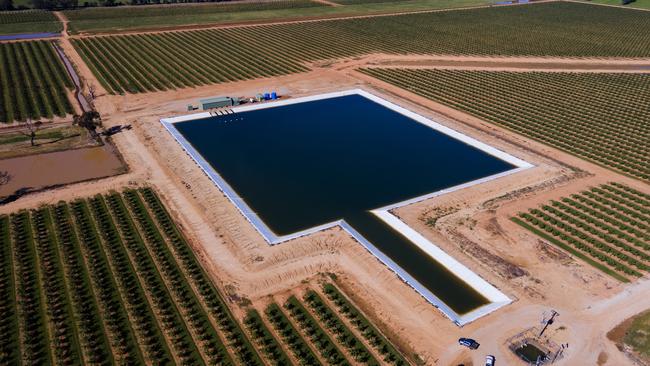
In the 10 years since Lenaghan – a former Ballarat country boy and trained agronomist – founded goFARM in 2013, it has grown to become a leading agribusiness owning land and water assets in southern NSW, northern Victoria and Tasmania, with more than 100 employees.
It is currently developing eight large parcels of farmland covering more than 50,000 hectares, including the 6300-hectare Sandmount Farms around Katunga and Cobram. It has also gathered $300 million of secure irrigation water entitlements in the Murray and Murrumbidgee River system in the past eight years to help achieve its “step change” productivity boosts, including growing high water-demand tree crops such as almonds.
“We prefer to make big bets on a limited number of key opportunities,” says Lenaghan, who has plans to expand goFARM’s acquisitions into other states and commodity sectors to further spread risk. “We then develop that land, focusing on transitioning assets and natural resources to their highest and best use.”
It’s a different way of looking at local farming opportunities that has won Lenaghan and goFARM reputations as astute and savvy operators.
“Every project is different but, whatever we end up growing, we are about long-term commitment to our staff, the local community and to Australian agriculture; we are in this for the long haul, not short-term profits,” explains Lenaghan.
“What we do is good for jobs, good for the regions, obviously good for us and our investors too, but also good for helping the sector grow.”
Danny Thomas, head of national rural property agent LAWD, is both a close friend of Lenaghan’s and a keen observer of goFARM’s impressive acquisitions and conversions.
“Liam is a deep thinker, always on the lookout for assets that the market has mispriced, or those situations where there is an untapped potential,” Thomas says.
Thomas credits goFARM’s success to their experience, knowledge of the value of what they are planning to grow, and their “research to the nth degree”, all while keeping the units of machinery and people per hectare required to a minimum.
“Liam has always been about high-risk high-return (projects),” he says. “But really the only risk is if you don’t agree with his hypothesis and research that says you can, for example, grow almonds north of Shepparton where it has never been done before.”
ONE OF SEVEN IN BALLARAT
To understand Lenaghan’s drive for agricultural improvement, his childhood up on a sheep farm north of Ballarat is instrumental.
Lenaghan was the third of seven children, born into a fifth-generation Irish Catholic farming family, whose ancestors had either struck it lucky on the goldfields in the 1850s or, as Lenaghan likes to think, turned to bushranging. Either way, they had enough cash to buy a small farm near Clunes.
In turn, his father was one of 11. By the time he was forced to take over the farm, missing out on an education, it still ran sheep as it had for the previous 100 years.
“Looking back, that’s where I first saw under-utilisation of farmland,” Lenaghan recalls. “Dad just wanted sheep, yet we had this beautiful soil ideal for potatoes and abundant water, but frustratingly I could never change his mind.”
It was also drummed into all his children that farming was for mugs, there was no money or future in agriculture.
For Lenaghan, who reckons the first word he ever uttered as a toddler was “farm”, it was a career killer.
Told he would never inherit or work the family farm, he turned from dux of Ballarat’s St Patrick’s College in years 7-10, to an average angry-with-the-world student.
Luckily he passed his final year with enough marks for his mother to enter her wayward son into an agricultural science degree at the University of Melbourne, backed by a scholarship from the Department of Agriculture.
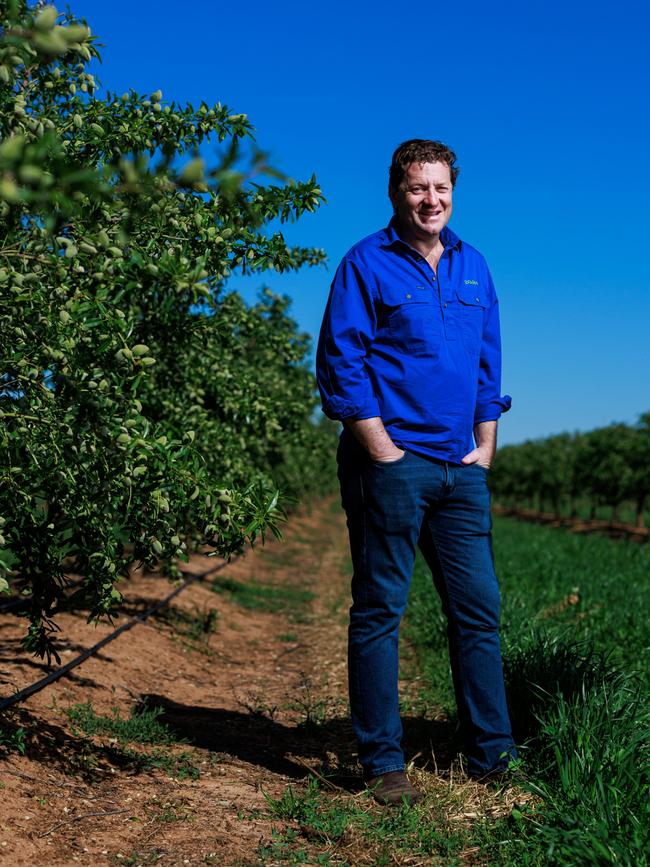
“All I ever wanted was to be a farmer, so I wasn’t thrilled,” says Lenaghan of his early days at uni. “But now I realise part of what has driven me my whole life is wanting to prove the old bugger wrong and show there’s still opportunities and plenty of wealth to be made in farming.
“And because the pathway I thought was right for me (returning to the family farm) wasn’t open to me, at goFARM I now get a real buzz out of creating opportunities and opening some doors to help give other (young people).”
But one hangover legacy from Lenaghan’s childhood persists. There is not a Merino ewe, dairy cow or beef steer to be found grazing in the paddocks of the goFARM portfolio.
“I just think the headwinds are against livestock enterprises; whereas all the best indicators point to an ongoing and growing demand for plant proteins,” Lenaghan says. “And all my knowledge base is in plant-based industries.”
Lenaghan says if he did contemplate a livestock enterprise, there would have to be a clear point of difference from other producers. “But that’s not to say I never would, and the current market with its low prices might be just that opportunity; it’s not often you can buy a steer for $300 or 100,000 sheep for $100,000.”
THE ‘UGLY DUCKLING’ LAKE BOGA
The blue tractor creeps carefully out on to the mounded red soil paddocks of Lake Boga near Swan Hill, leaving hundreds of small tomato seedlings neatly sown in its wake.
It’s the start of a massive spring tomato planting program at its Lake Boga property by goFARM, part of the 12-month transformation of its newest farmland acquisition bought last year from Aware Super fund and Kilter Rural for $30 million.
Farm manager Tom Farmer has 14 million tomato plants to sow in the next few weeks, as goFARM focuses on growing 80,000 tonnes of high-value field tomatoes this summer at Lake Boga to supply the Kogame tomato paste and sauce factory in Echuca with a massive 40 per cent of its needs.

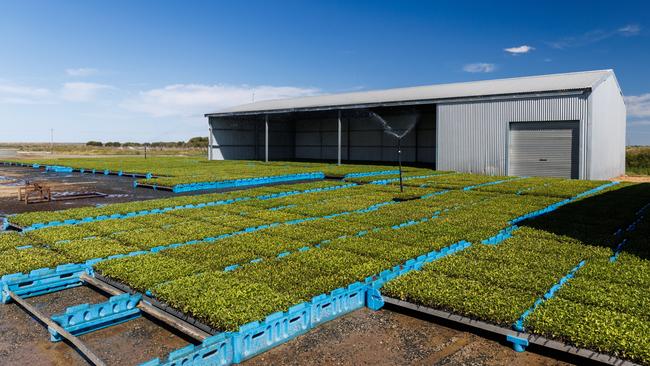
It’s a different project for goFARM, as it was Aware Super – formerly known as VicSuper – that originally bought and amassed more than 90 marginal dairy farms and 9000 hectares of highly salt-affected land over the past 17 years to form the Lake Boga aggregation. And then spent more than $80 million ripping up fences and installing new irrigation channels, overhead pivot irrigators, dams, major power systems and underground drip tape.
Sold in a virtual fire sale for less than a third of the massive $120 million capital injected by the superannuation fund into developing the aggregation, Lenaghan describes the purchase of the Lake Boga holding as like buying an “ugly duckling”.
“It wasn’t undercapitalised – far from it – but that infrastructure was under-utilised and the whole enterprise was overly complex, unloved and definitely not producing the returns it should,” Lenaghan says.
“But we could see that by concentrating and simplifying what the farm did, there was a real opportunity to enhance outcomes.”
GoFARM proceeded to sell off 4000ha on both the northern and southern fringes of the large holding to neighbours, hanging on to its highly improved core.
The focus instead became the subsurface irrigating of more than 1200 hectares to enlarge the existing tomato growing areas in rotation with irrigated winter crops such as barley, faba beans and canola grown under vast centre pivots.
In the process, goFARM has already reaped nearly $15 million back from land sales in less than a year.
When the value of the large 8176 megalitres of water entitlements that goFARM acquired with the Lake Boga purchase is taken into account, Lenaghan believes it equates to getting the farm and its infrastructure virtually free.
“It’s come a long way in a short time; it’s not quite a ‘swan’ yet, but we are getting there in our transformation of the project and its productivity, which is what goFARM’s point of difference is all about,” he says.
Further north from Swan Hill, one of goFARM’s most ambitious projects, Canally Almond Orchards, is coming close to fruition.
In 2016, after considerable research, it bought nine adjoining dry wheat cropping farms covering 9000 hectares between Balranald and Boundary Bend at the junction of the Murray and Murrumbidgee rivers, from local families just as severe drought was hitting the region hard.
By adding water entitlements to the land, goFARM – together with a US pension fund – has planted 5000 hectares of suitable land to 1.5 million almond trees, all fed by an above-ground irrigation system to every tree.
Canally is now the third-biggest almond farm and producer in Australia, with 60 employees and a new $100 million almond processing plant currently being built at Cadell.
Altogether, the transformation of once-average dry cropping country by goFARM and its US partner has created one of the largest horticultural aggregations in Australia with an investment value of $450 million.
“We couldn’t do it without owning water; we’ve committed serious money to the allocation of water, which allows us to manage risk – more than a third of our investment ($300-350m) is held as water entitlements,” Lenaghan says.
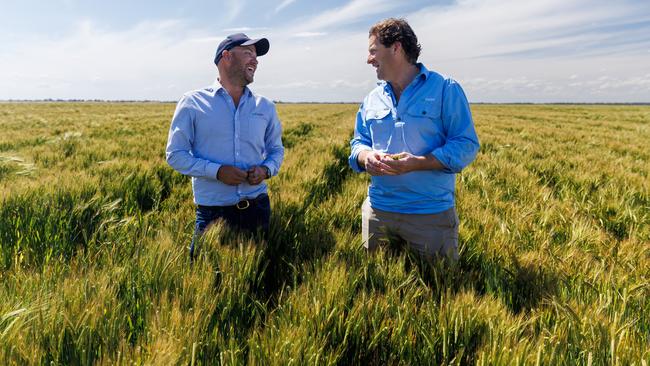
“More government buybacks of water will diminish the available water consumption pool and entitlement values will go up; it’s a natural resource asset just like land that should be put to its best use.”
A NATURAL PARTNERSHIP
None of goFARM’s big dreams and visions would be possible without significant capital funding.
While Lenaghan owns half the goFARM investment company, its other half is funded by the wealth of Robert Costa, the late Anthony Costa and their families, through their family investment vehicle, Costa Asset Management.
The Costa family made their fortune from large-scale fruit and vegetable wealth farming and wholesale marketing, with the public listing of the $1.5 billion Costa Group on the ASX leaving the three brothers, Frank, Robert and Anthony with cash to invest.
Robert Costa had known Lenaghan as a young man working as an agronomist in rural Victoria for many years. So when Lenaghan decided to go out on his own and found goFARM – and by 2015 was looking for capital to fund his first farm projects – Costa said it was a natural fit for the pair to team up.
“He’s totally committed to the cause of Australian agriculture,” Robert Costa says. “And given my background in the horticulture industry and my own great affinity with agriculture, it was very easy for us to join together in (owning) goFARM and for me to feel comfortable investing in his projects.”
Costa, who has about 22 per cent of his family wealth tied up in goFARM, says that because a big share of the total land and water investment is by Lenaghan and himself, there is also a preparedness to hang on to the farms after they have been transformed and manage them for the next 20 years, if the returns are forecast to continue to build over the long term.
“It’s not like buying shares in BHP; it’s much more interesting and exciting,” Costa says. “Each project is a living thing on its own; it’s transforming land that can’t support family farms anymore, aggregating them and transitioning grazing land into horticulture and producing a higher value product; it’s tremendously rewarding.”
Another of Lenaghan’s mentors when he was a young man with “fire in his belly and something to prove” by going out on his own at the age of 35, is former NAB Agribusiness head and ubiquitous agricultural company director Mike Carroll.
He recalls encouraging Lenaghan to study how some of the biggest and wealthiest names in agriculture – many of which Carroll had advised – had made their enduring riches; families like the Harrises of Moree, the Santis of Port Lincoln, Doug Shears at Hillston, WA’s Gina Rinehart, the Zadros of Bundaberg and the Presslers from Emerald.
In doing so, Lenaghan stumbled upon the secret to extreme wealth creation in agriculture.
“They were all good operators but what they had in common was that their serious wealth had flowed from land use change and capturing property or water rights, quotas or licences,” Lenaghan says.

Carroll says that was the moment that Lenaghan realised his future was not just about being a farmer, but a rural property developer.
“I always thought Liam would do well because he’s a practical, energetic person with great farming knowledge, but with Robert Costa’s significant backing he has created a very substantial agribusiness that is really contributing to the regions and that national economy,” Carroll says.
ACTIONS SPEAK THE LOUDEST
It’s not always easy being a catalyst for change in conservative farming Australia.
Many times, the arrival of goFARM in a district has initially been seen more as harbinger of doom and gloom; one of the reasons the company name isn’t plastered on its front gates.
Lenaghan is used to all the accusations and misconceptions.
That he is a water baron come into a district to buy and take away its irrigation water leaving the districts parched. Or that goFARM is effectively shutting down small Mum-and-Dad dairy farms, and planting crops instead.
“When we come into an area we are usually regarded as the face of change; while we think there is an opportunity to enhance outcomes for everyone, we are usually received at first with different levels of cynicism, abuse, praise, negativity and disinformation,” Lenaghan says.
“You can fight that, but we think the best way to win the hearts and minds of the local community is to demonstrate what we are about; to let our actions speak loudest.”
For example, when goFARM started buying dozens of dairy farms around Katunga, the local gossip was that all the water entitlements attached to the farms would be heading downstream to Canally’s vast almond orchards. Instantly, Lenaghan immediately started sowing a highly visible large sweet corn crop to use the local water and “demonstrate our commitment to the area”.
And when goFARM took over the Lake Boga aggregate last year to great local distrust, it took October 2023’s devastating floods and the loaning of all the farm’s heavy equipment – driven by manager Tom Farmer and his team – to build an urgently needed levy bank around the threatened river town of Benjeroop before the doors of the community opened wide.
“We simply said our company policy was to keep everyone safe; that it was community protection first, our fixed assets second and our crops thirds,” says Farmer. “Things changed quickly from then.”
Another company policy is always to buy goods and equipment as locally as possible.
“And bringing more capital and skilled people into rural areas has to be a good thing … long term there is the potential for value-adding processing linked to our new crops and exports – like the $100 million Cadell almond processing plant ,” Lenaghan says.
But he wouldn’t be doing anything else other than running goFARM.
“I’m never content; we’ve done so much better and achieved so much more than I would have predicted a decade ago, but we’re only getting started.”
Rural land at peak value
As an investment manager geared to buying farmland cheap and spending millions on transforming low-value farms into high-value intensive and irrigated agriculture, there is scarcely a better person than Liam Lenaghan to ask about rural land values.
In May at the Global Food Forum, Lenaghan said farm prices had settled or plateaued at record levels but that low cattle and sheep prices combined with an uncertain seasonal outlook had made land buyers more “cautious”.
By late July, Lenaghan was provocatively calling the start of a rural land value collapse or, at least, a “huge correction”.
He publicly said land prices had become “completely overinflated” in some districts and were already starting to drop.
“I don’t think prices are going to plateau, I think they are going to collapse in terms of land prices; we are seeing it already.
“In the last year or 18 months ago, in the glorified region of the Victorian Western District, farmland was selling for $12,000-$15,000 an acre ($29,500-$37,000 a hectare); now it has to be a cracking joint to make $8000 to $9000 bucks an acre ($19,700-$22,000 a hectare).”
“We all pretend it’s not there but it’s got to happen because there is too much cheap money and people do silly things,” he said, forecasting some farming businesses would find it tough to survive because they had continued to budget on record high cattle, sheep and farmland returns.
This month, Lenaghan told AgJournal that land values were reverting to the average, with many but not all of rural Australia overpriced.
“GoFARM is not immune to this adjustment; our land assets were definitely worth less today on paper than they were a month ago,” Lenaghan says of the 50,000 hectares of farmland in his company’s expansive portfolio.
“But I would argue our increased water efficiency, increased production and continuing development of our irrigated assets – plus the lack of any downward pressure on our water values with an El Nino on the cards – more than offsets those headwinds and may even create some (buying) opportunities.”
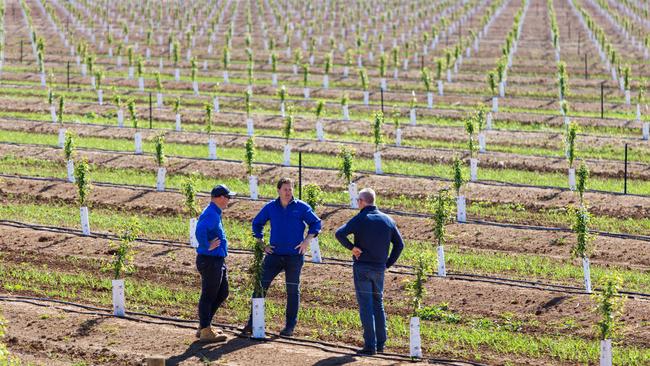
Helping farmers of the future
GoFARM founder and managing director Liam Lenaghan credits a university scholarship funded by the Victorian Department of Agriculture for sparking his passion for agriculture.
Lenaghan is now fully committed to giving the next generation a similar helping hand, and in the process overcome the critical shortage of skilled young agricultural and horticultural graduates to work in Australian agriculture.
“I’ve been fortunate along the way, at different points, where people have backed me, seen some potential, and have been prepared to invest time, guidance, mentorship and sometimes money,” Lenaghan says.
“But the real catalyst was the Department of Agriculture scholarship and cadetship that set me on this pathway right at the start; our (goFARM) Graduate Program is a direct result of that.”
Last year, goFARM was part of a $1.3 million initiative to help fund 10 annual scholarships for low socio-economic and First Nations students studying horticulture, agriculture, agricultural science, agricultural business management and viticulture degrees at Wagga’s Charles Sturt University.
The AGcessibility Kickstart Scholarships, funded together with goFARM’s investment partners, the Anthony Costa Foundation and Australian Farming Services, provide $5000 a year for three years to each recipient.
Anna Kennan, 25, describes her participation in goFARM’s graduate development program as “life changing”. She now is employed full time by goFARM in its Melbourne head office as head of investor relations.
“With the global population being set to peak above nine billion and the likely shortage of food and protein at the same time as climate change is happening, I could really see the importance of being able to do more with less,” Kennan says.
“So the prospect of working with goFARM with its purpose of transforming Australian agriculture with a focus on greater productivity of the land, innovation led by research and using scarce resources like water better, was very exciting to me.”
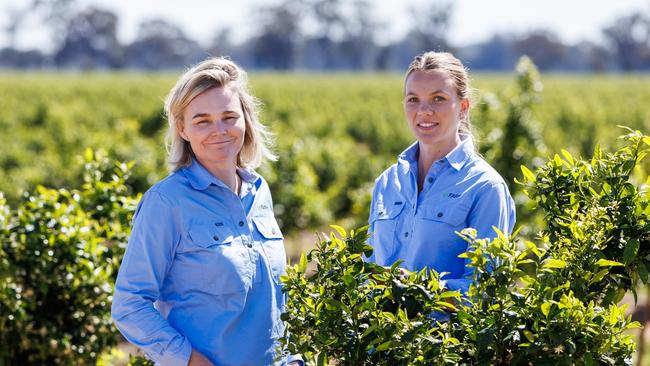
GOFARM’S AGGREGATIONS
PETRO STATION, WENTWORTH
● 26,673-hectare Petro Station bought as grazing land in 2017
● Paid $11.8 million for land and some water rights
● $2 million more invested to convert 9600 hectares to highly productive no-till cropping, with biodiversity conservation zones
● A desalination plant installed, also extensive national cropping trials being hosted
NARANGA PROPERTY TRUST, SWAN HILL
● Owns significant water entitlements on both the Murray and Goulburn systems
● 300 hectares at Woorinen (currently on the market)
GOULBURN GOLD, MOOROOPNA
● Four dairy farms totalling 1200 hectares bought in 2022-23 plus 8500 megalitres water
● Being converted to 750 hectares of irrigated almonds plus tomatoes and vegetables
SANDMOUNT FARMS, KATUNGA-COBRAM
● Bought 75 small dairy farms plus water rights north of Shepparton in 2018-20, totalling 6300 hectares
● $250 million invested and another $200 million planned
● Being converted to irrigated almond, citrus, field tomatoes and corn production, plus winter cereal crops on rotation
CANALLY AND CADELL, BALRANALD
● 9000 hectares, bought in
● Almond plantations valued at $450m
● Joint venture with US backed Australian Farming services
● Also includes new $100m solar-powered almond processing plant at Cadell, now under construction
RIVERINA PROPERTY TRUST, GRIFFITH
● Three vineyard and melon-cotton farms bought in September 2023
● $120 million commitment
● 1800 hectares plus MIA water rights
● Being converted to almonds
LAKE BOGA
● 5000 hectares of mainly irrigated land between Kerang and Lake Boga including Victoria’s biggest tomato fields, as well as cereal crops under centre pivots, with plans to convert some to almonds
● Bought as a 9000-hectare conglomerate for $30 million in August 2022 from Aware Super and Kilter Rural, who had put it together from 38 small salinity-affected dairy and grazing farms over 15 years
● GoFARM also bought 8167 megalitres of low-reliability water entitlements for about $30 million
● Since then, goFARM has sold 4000 hectares of the original farmland, including conservation land, Davidson’s plum orchards and dryland cropping country, to neighbours for $30 million
TASMANIAN PREMIUM LAND TRUST
● Four grazing farms in the Tamar Valley near Launceston bought in 2019
● $60 million invested
● Being converted to high-value cool climate wine grape production




